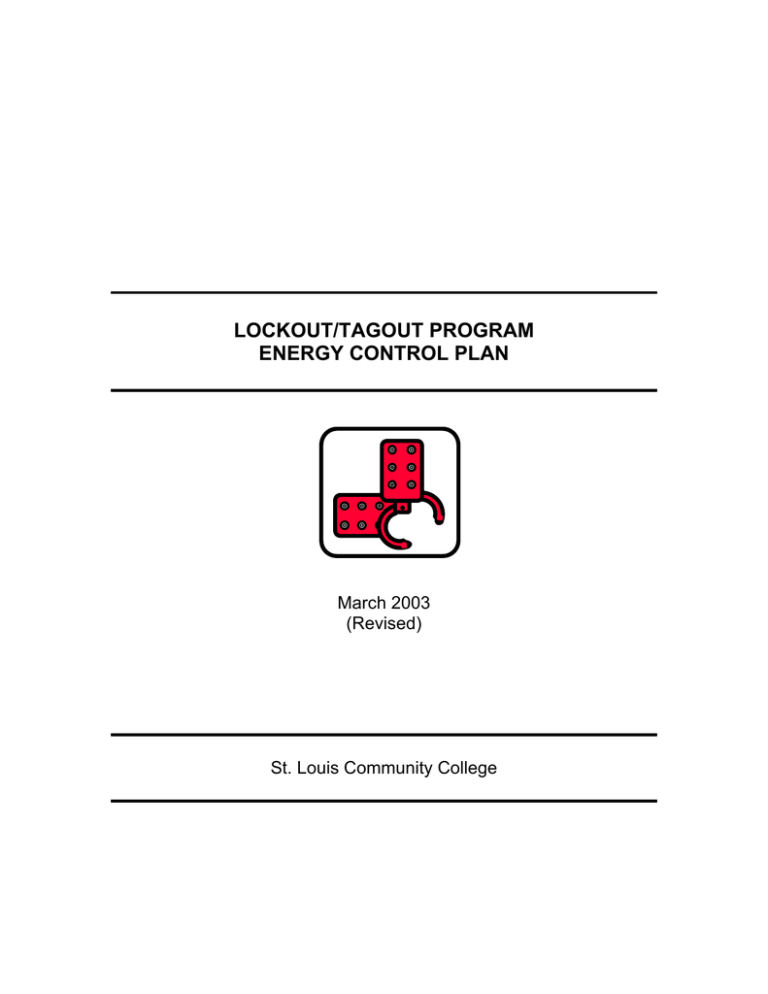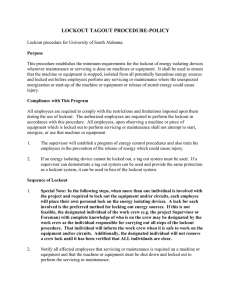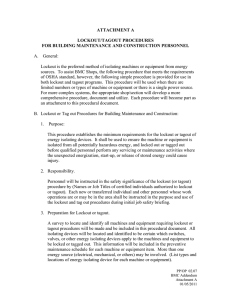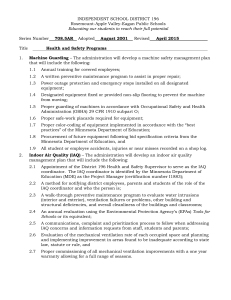LOCKOUT/TAGOUT PROGRAM ENERGY CONTROL PLAN March 2003
advertisement

LOCKOUT/TAGOUT PROGRAM ENERGY CONTROL PLAN March 2003 (Revised) St. Louis Community College Table of Contents Title Section # Page # 1 Purpose 1 2 Applicability 2 3 Program Overview 3 4 Energy Control Procedures 4 5 Group Lockout/Tagout 7 6 Lockout/Tagout Equipment 8 7 Training and Communication 9 8 Key Definitions 11 Appendices Appendix A Lockout/Tagout Procedures Appendix B Lockout/Tagout Devices i SECTION 1 - PURPOSE This lockout/tagout program covers the servicing and maintenance of machines and equipment in which the unexpected energization or start up of the machines or equipment, or release of stored energy could cause injury to employees. The purpose of this lockout/tagout program is to ensure that the machine or equipment is isolated from all potentially hazardous energy, and locked out or tagged out before employees perform any servicing or maintenance activities where the unexpected energization, start-up or release of stored energy could cause injury. St. Louis Community College has established an energy control program which includes the following elements as outlined in this written program: • • • • Energy Control Procedures, Group Lockout/Tagout Procedures, Lockout/Tagout Equipment, and Employee Training. 1 SECTION 2 - APPLICABILITY This written program applies to the control of energy during servicing and/or maintenance of machines and equipment. This written program does not apply to servicing/maintenance during normal operations (i.e., the utilization of a machine or equipment to perform its intended production functions) unless: • • An employee is required to remove or bypass a guard or other safety device; or An employee is required to place any part of his or her body into an area on a machine or piece of equipment where work is actually performed upon the material being processed (point of operation) or where an associated danger zone exists during a machine operating cycle. Note: Minor tool changes and adjustments, and other minor servicing activities, which take place during normal production operations, are not covered by this written program if they are routine, repetitive, and integral to the use of the equipment for production, provided that the work is performed using alternative measures which provide effective protection. Exemption In addition, this written program does not apply to the following: • Work on cord and plug connected electric equipment for which exposure to the hazards of unexpected energization or start up of the equipment is controlled by the unplugging of the equipment from the energy source and by the plug being under the exclusive control of the employee performing the servicing or maintenance. 2 SECTION 3 - PROGRAM OVERVIEW The area supervisor or his/her designee is responsible for overseeing the lockout/tagout program in their areas of responsibility. Lockout procedures will be used for all energy isolating devices which are capable of being locked out. It should be noted that whenever equipment is replaced or undergoes major repairs, and whenever new machines or equipment are installed, St. Louis Community College will ensure that energy isolating devices the machines are designed to accept a lockout device. 3 SECTION 4 - ENERGY CONTROL PROCEDURES St. Louis Community College has developed, documented and utilized energy control procedures for the control of potentially hazardous energy when employees are engaged in the activities covered by this written program. These procedures are presented in Appendix A. Lockout or tagout will be performed only by the authorized employees who are performing the servicing or maintenance, using the procedures in Appendix A. In addition, affected employees will be notified by the authorized employee of the application and removal of lockout devices or tagout devices. Notification will be given before the controls are applied, and after they are removed from the machine or equipment. The procedures clearly and specifically outline the scope, purpose, authorization, rules, and techniques to be utilized for the control of hazardous energy, and the means to enforce compliance including, but not limited to, the following: • A specific statement of the intended use of the procedure; • Specific procedural steps for shutting down, isolating, blocking and securing machines or equipment to control hazardous energy; • Specific procedural steps for the placement, removal and transfer of lockout devices or tagout devices and the responsibility for them; and • Specific requirements for testing a machine or equipment to determine and verify the effectiveness of lockout devices, tagout devices, and other energy control measures. The procedures provided in Appendix A cover the following elements and actions in the following sequence: • Preparation for shutdown The equipment should be surveyed to identify all isolating devices. Verify which switch(es), valve(s) or other energy isolating devices apply to the equipment to be locked or tagged out. It should be noted that more than one energy source (electrical, mechanical, or others) may be involved. After the equipment has been surveyed, the individual performing the lockout on the equipment must use their lockout/tagout equipment and/or select the appropriate lockout devices from the work area. Example: If the lockout will require more than one person working on the equipment, then a group lockout device must be used. Note: If lockout is expected to carry over from one shift to the next shift, a group lockout device must be used. 4 Sequence of Lockout 1. Notify all affected employees that a lockout or tagout system is going to be utilized and the reason for the lockout/tagout. The authorized employee shall know the type and magnitude of the energy that the machine or equipment utilizes and shall understand the hazards. 2. If the machine or equipment is operating, shut it down by the normal stopping procedure (depress stop button, open toggle switch, etc.) 3. Operate the switch, valve or other energy isolating device(s) so that the equipment is isolated from its energy source(s). Stored energy (such as that in springs, elevated machine members, rotating flywheels, hydraulic systems and air, gas, steam or water pressure, etc.) must be dissipated or restraned by methods such as repositioning, blocking, bleeding down, etc. 4. Lockout and/or tagout the energy isolating devices with assigned individual lock(s) or tag(s). 5. Ensure that no personnel are exposed, and verify that the energy source has been disconnected by operating the push button or other normal operating controls to make certain the equipment will not operate. Hydraulic and electrical equipment must be checked to ensure they are disconnected. Caution: Return the operating control(s) to the "neutral" or "off" position after the test. 6. The equipment is now locked or tagged out. Restoring the Machine or Equipment to Normal Operation 1. After the servicing and/or maintenance is complete and the equipment is ready for normal production operations, check the area around the machines or equipment to ensure that no one is exposed. 2. After all tools have been removed from the machines or equipment, guards have been reinstalled and employees are in the clear, remove all lockout or tagout devices. Operate the energy isolating devices to restore energy to the machine or equipment. Shift Change Lockout 5 When a lockout of a piece of equipment is going to carry over from one shift to the next, a group lockout device will be used. The oncoming shift will be notified about the lockout device. The oncoming individual responsible for this lockout will apply his lock to the equipment. The individual who has just completed his shift will remove his lock, indicating that he is no longer responsible for that equipment. NOTE: The person completing their shift MUST NOT remove their lock before the oncoming worker has applied his lock. Basic Rules for Using Lockout or Tagout System Procedure All equipment shall be locked out or tagged out to protect against accidental or inadvertent operation when such operation could cause injury to personnel. Do not attempt to operate any switch, valve or other energy isolating device when it is locked or tagged out. When a lock is installed during lockout operations, the key will be kept by the individual until his lock has been properly removed. 6 SECTION 5 - GROUP LOCKOUT/TAGOUT During those times when servicing and/or maintenance is performed by multiple personnel, they will utilize a procedure which affords the employees a level of protection equivalent to that provided by the implementation of a personal lockout or tagout device. When more than one individual is required to lockout or tagout equipment, each shall place his/her own personal lockout device or tagout device on the energy isolating device(s). When an energy isolating device cannot accept multiple locks or tags, a multiple lockout or tagout device (hasp) may be used which allows the use of multiple locks to secure it. As each person no longer needs to maintain his or her lockout protection, that person will remove his/her lock. Group lockout or tagout devices must be used and the following specific requirements must be followed: • Primary responsibility is vested in an authorized employee for a set number of employees working under the protection of a group lockout or tagout device (such as an operations lock); • Provision for the authorized employee to ascertain the exposure status of individual group members with regard to the lockout or tagout of the machine or equipment; • When more than one group is involved, assignment of overall job-associated lockout or tagout control responsibility to an authorized employee designated to coordinate affected work forces and ensure continuity of protection; and • Each authorized employee must affix a personal lockout or tagout device to the group lockout device, group lockbox, or comparable mechanism when he or she begins work, and must remove those devices when he or she stops working on the machine or equipment being serviced or maintained. 7 SECTION 6 - LOCKOUT/TAGOUT EQUIPMENT St. Louis Community College has equipment on site for isolating, securing or blocking of machines or equipment from energy sources when implementing lockout/tagout procedures. Lockout devices and tagout devices: • Are singularly identified; • Are the only device(s) used for controlling energy; and • Are not used for other purposes. All lockout and tagout devices are durable. The devices must be capable of withstanding the environment to which they are exposed for the maximum period of time that exposure is expected. In addition, tagout devices must be constructed and printed so that exposure to weather conditions or wet and damp locations will not cause the tag to deteriorate or the message on the tag to become illegible. If tags are used in corrosive environments such as areas where acid and alkali chemicals are handled and stored, St. Louis Community College will ensure that the tags can withstand the environment. Lockout and tagout devices are standardized within the facility in at least color; shape; or size; and additionally, in the case of tagout devices, print and format must also be standardized. Tagout devices, including their means of attachment, must be substantial enough to prevent inadvertent or accidental removal. Tagout device attachment means must be of a non-reusable type, attachable by hand, self-locking, and nonreleasable with a minimum unlocking strength of no less than 50 pounds and having the general design and basic characteristics of being at least equivalent to a one-piece, all environment-tolerant nylon cable tie. Lockout devices and tagout devices will indicate the identity of the employee applying the device(s). They will also warn against hazardous conditions if the machine or equipment is energized and will include a legend such as the following: "Do Not Start. Do Not Open. Do Not Close. Do Not Energize. Do Not Operate." Specific details about the lockout/tagout equipment used at St. Louis Community College is presented in Appendix B. 8 SECTION 7 - TRAINING AND COMMUNICATION Employee training is provided to ensure that the purpose and function of the lockout/tagout program are understood by employees. The purpose of the training is to ensure that employees have the knowledge and skills required for the safe application, usage, and removal of the energy controls. Training will be provided to authorized and affected employees. The training will include the following: Authorized Employees Each authorized employee will receive training in the following: • The purpose and use of the energy control procedure; • How to recognize applicable hazardous energy sources; • Types and magnitude of the energy available in the workplace; and • Methods and means necessary for energy isolation and control; Affected Employees Affected employees, or all other employees whose work operations are or may be in an area where energy control procedures may be utilized, will also be provided with training. This training will include the following: • Basic lockout/tagout procedures; and • Restrictions relating to attempts to restart or reenergize machines or equipment which are locked out or tagged out. When tagout systems are used, employees will also be trained in the following limitations of tags: • Tags are essentially warning devices affixed to energy isolating devices, and do not provide the physical restraint on those devices that is provided by a lock. • When a tag is attached to an energy isolating means, it is not to be removed without authorization of the authorized person responsible for it, and it is never to be bypassed, ignored, or otherwise defeated. • Tags must be legible and understandable by all authorized employees, affected employees, and all other employees whose work operations are or may be in the area, in order to be effective. 9 • Tags and their means of attachment must be made of materials which will withstand the environmental conditions encountered in the workplace. • Tags may evoke a false sense of security, and their meaning needs to be understood as part of the overall energy control program. • Tags must be securely attached to energy isolating devices so that they cannot be inadvertently or accidentally detached during use. Employee retraining Employees will be retrained whenever there is a change in their job assignments, a change in machines, equipment or processes that present a new hazard, or when there is a change in the energy control procedures. Additional retraining will also be conducted whenever a periodic inspection reveals, or whenever the program administrator has reason to believe that there are deviations from or inadequacies in the employee's knowledge or use of the energy control procedures. The retraining will reestablish employee proficiency and introduce new or revised control methods and procedures, as necessary. New Employees Each new or transferred affected or authorized employee and other employees whose work operations are or may be in the area shall be instructed in the purpose and use of the lockout/tagout procedure. 10 SECTION 8 - KEY DEFINITIONS Affected employee: An employee whose job requires him/her to operate or use a machine or equipment on which servicing or maintenance is being performed under lockout or tagout, or whose job requires him/her to work in an area in which such servicing or maintenance is being performed. Authorized employee: A person who locks out or tags out machines or equipment in order to perform servicing or maintenance on that machine or equipment. An affected employee becomes an authorized employee when that employee's duties include performing servicing or maintenance covered under this section. Capable of being locked out: An energy isolating device is capable of being locked out if it has a hasp or other means of attachment to which, or through which, a lock can be affixed, or it has a locking mechanism built into it. Other energy isolating devices are capable of being locked out, if lockout can be achieved without the need to dismantle, rebuild, or replace the energy isolating device or permanently alter its energy control capability. Energized: Connected to an energy source or containing residual or stored energy. Energy isolating device: A mechanical device that physically prevents the transmission or release or energy, including but not limited to the following: A manually operated electrical circuit breaker, a disconnect switch, a manually operated switch by which the conductors of a circuit can be disconnected from all ungrounded supply conductors and, in addition, no pole can be operated independently; a line valve; a block; and any similar device used to block or isolate energy. Push buttons, selector switches and other control circuit type devices are not energy isolating devices. Energy source: Any source of electrical, mechanical, hydraulic, pneumatic, chemical, thermal, or other energy. Hot tap: A procedure used in the repair maintenance and service activities which involves welding on a piece of equipment (pipelines, vessels or tanks) under pressure, in order to install connections or appurtenances. It is commonly used to replace or add sections of pipeline without the interruption of service for air, gas, water, steam, and petrochemical distribution systems. 11 Lockout: The placement of a lockout device on an energy isolating device, in accordance with an established procedure, ensuring that the energy isolating device and the equipment being controlled cannot be operated until the lockout device is removed. Lockout device: A device that utilizes a positive means such as a lock, either key or combination type, to hold an energy isolating device in the safe position and prevent the energizing of a machine or equipment. Included are blank flanges and bolted slip blinds. Normal production operations: The utilization of a machine or equipment to perform its intended production function. Servicing and/or maintenance: Workplace activities such as constructing, installing, setting up, adjusting, inspecting, modifying, and maintaining and/or servicing machines or equipment. These activities include lubrication, cleaning or unjamming of machines or equipment and making adjustments or tool changes, where the employee may be exposed to the unexpected energization or startup of the equipment or release of hazardous energy. Setting up: Any work performed to prepare a machine or equipment to perform its normal production operation. Tagout: The placement of a tagout device on an energy isolating device, in accordance with an established procedure, to indicate that the energy isolating device and the equipment being controlled may not be operated until the tagout device is removed. Tagout device: A prominent warning device, such as a tag and a means of attachment, which can be securely fastened to an energy isolating device in accordance with an established procedure, to indicate that the energy isolating device and the equipment being controlled may not be operated until the tagout device is removed. 12



